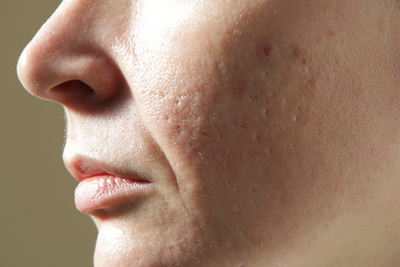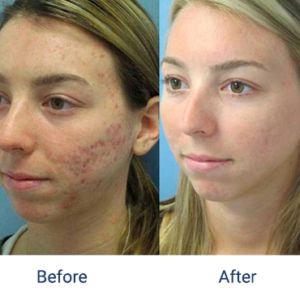Acne Scar Treatment
 Acne scars result from acne and blemishes that damage the skin. Scarring can be expected depending on the type of acne and how often you pick at pimples. Luckily, there are ways to reduce the appearance of acne scars, some of which even target active breakouts. At Schweiger Dermatology Group, our acne specialists are ready to help you get rid of red and dark scars for good.
Acne scars result from acne and blemishes that damage the skin. Scarring can be expected depending on the type of acne and how often you pick at pimples. Luckily, there are ways to reduce the appearance of acne scars, some of which even target active breakouts. At Schweiger Dermatology Group, our acne specialists are ready to help you get rid of red and dark scars for good.
Types of Acne Scars
Acne scars aren’t all the same. In fact, there are three general categories of scars, including atrophic, hypertrophic, and keloid. In some cases, you can also develop post-inflammatory hyperpigmentation, or PIH, which creates a dark mark on the skin. These and other kinds of scarring can make you uncomfortable with your appearance, but they are treatable with the right approach.
Ice Pick Scars
Ice pick scars appear as small, sharp indentations, often described as looking like the skin has been punctured with an ice pick. Due to their depth, they are often considered the most difficult type of acne scar to treat despite being the most common atrophic acne scars.
Boxcar Scars
These scars are wider than ice pick scars, typically 1.5 to 4.0mm in diameter. They have a round or oval shape with sharp, defined edges, giving them a pitted appearance. Boxcar scars can be further classified as shallow (0.1-0.5mm deep) or deep (≥0.5mm deep). Shallow boxcar scars are generally more responsive to skin resurfacing treatments, while deep boxcar scars are more resistant.
Hypertrophic Scars
Hypertrophic scars are raised and thickened scars that occur when collagen is overproduced during the healing process. Unlike atrophic scars, hypertrophic scars represent a net gain of collagen. These scars remain within the boundaries of the original acne lesion and are more common along the jawline, chest, and upper back.
Rolling Scars
Rolling scars are recognized by their wavy appearance, creating a rolling effect on the skin’s surface. These scars are typically wider than others, sometimes reaching up to 5mm in diameter. Rolling scars are caused by fibrous bands that form between the epidermis and deeper layers of the skin, pulling the surface down in an uneven pattern.
Keloid Scars
Keloid scars are a more severe form of raised scarring that extends beyond the original acne lesion. Like hypertrophic scars, keloids are caused by an overproduction of collagen. However, keloids continue to grow. They are often darker in color than the surrounding skin and can be itchy or painful. Keloid scars are particularly challenging to treat and have a high risk of returning even after successful treatment.
What Causes Acne Scars?
Acne scars are lasting reminders of the skin’s complex healing process following severe acne. These scars develop when the body’s natural repair mechanisms are overwhelmed by intense inflammation and tissue damage. The primary culprit is often deep, cystic acne that penetrates the skin’s lower layers, destroying collagen and elastin fibers. As the body rushes to repair this damage, it may produce too little or too much collagen, resulting in different types of scars.
Factors such as genetics play a role in acne scarring, influencing how the skin responds to inflammation and heals. Delayed or improper treatment of acne can also exacerbate scarring. Additionally, picking or squeezing acne lesions can lead to scarring due to trauma and bacteria entering the affected area. Environmental factors like sun exposure can worsen the appearance of scars by causing hyperpigmentation.
Will Acne Scars Fade Away?
While reddish or brownish acne marks may fade eventually, true acne scars, especially deep or severe ones, are typically permanent unless treated appropriately. Mild to moderate scarring might slowly fade over time, but the process can be slow and unpredictable. Without targeted treatments, smooth skin becomes harder to achieve as scars may become more noticeable with age.
Dermatological Treatments for Acne Scars
Acne scar specialists offer an array of treatments that help improve skin texture and tone. Cosmetic procedures are the primary way to clear hyperpigmented skin, with the most effective treatment depending on the severity of the acne scarring.
Laser Treatment for Acne Scars
Laser treatments, like fractional CO2, F.A.S.T, and KTP, can be excellent for acne scars. Depending on the laser and how deep it heats the skin, laser treatments may be invasive, noninvasive, or minimally invasive. They may also have minimal or no downtime, making them a good choice for people with busy schedules.
PRP
PRP, which stands for platelet-rich plasma, is a treatment that uses your blood to correct deeply pitted acne. The technique involves injecting blood into the damaged tissue to help “fill in” the scars over time. At Schweiger Dermatology Group, we use the SELPHYL system. This system spins and separates the blood, allowing us to access the Platelet-Rich Fibrin Matrix (PRFM). This PRFM is made of pure platelets with growth factors that promote healing and the growth of elastin and collagen.
Chemical Peels for Acne Scars
Chemical peels involve applying a carefully formulated acidic solution to the skin, which helps exfoliate the outer layers and stimulate collagen production. As the treated skin peels away, it reveals smoother skin underneath, reducing the appearance of shallow acne scars and improving overall skin texture. While not a one-size-fits-all solution, chemical peels can be extra effective for rolling scars and some boxcar scars.
Microneedling and Microdermabrasion for Acne Marks
Microneedling and microdermabrasion both stimulate collagen production, but they do more than that. The procedure, which uses tiny needles (along with a numbing agent), causes controlled injury to the skin to encourage it to repair itself. These procedures may be combined with other treatments such as Laser Genesis or medicated skincare products.
How To Prevent Acne Scars
There are many methods for preventing acne scars, but the best one is to treat acne early and often. The longer you wait to treat an acne flare, the more likely you’ll have scarring. If you develop acne, remember not to pick at or pop your pimples. Doing so can damage the skin further, increasing the likelihood of scarring.
Additionally, avoid activities that can damage the skin, such as smoking or getting sunburnt. Finally, maintaining overall skin health through proper hydration, a balanced diet rich in antioxidants, and stress management can support the skin’s natural healing processes.
Acne Scar Removal at Schweiger Dermatology Group
At Schweiger Dermatology Group, we offer several different acne scar removal options to help your skin look and feel its best. You don’t have to endure pitted acne scars or continued outbreaks. We have non-invasive and minimally invasive treatment options to eliminate discoloration, improve the skin’s texture, and reduce pitting and raised scarring. Contact us today or find a location to schedule an appointment with one of our dark spot removal specialists.
Reviewed by Dr. Jason Miller.
Frequently Asked Questions About Acne Scars
-
Should you go to a dermatologist or plastic surgeon for acne scars?
Many people think they can take care of acne scars at home, and in some cases, that may be true. However, to understand your acne’s cause and determine the best options for removing scars, it’s a good idea to see a dermatology provider. While plastic surgeons can perform some treatments for acne scars, they are not typically the first line of treatment. Surgery is usually reserved for deep scars that don’t respond to other treatments.
-
Does retinol help with acne scars?
Retinol, a derivative of vitamin A, can help with acne scars. It promotes cell turnover, which means your pores are less likely to get blocked. It also has anti-inflammatory properties, making it great for improving skin texture and eliminating irritation. However, it can cause dryness at first, so get guidance from a dermatologist before you try it.
-
Is vitamin C good for acne scars?
Yes, like retinol, vitamin C is also great for acne scars. Vitamin C is an antioxidant, meaning it protects the skin from free-radical damage. It can also improve the appearance of hyperpigmentation, which means dark spots get lighter and less apparent. Vitamin C can also improve the overall tone of the skin.
-
Does microneedling get rid of acne scars permanently?
While microneedling can significantly improve the appearance of acne scars, it may not eliminate them in all cases. The treatment works by stimulating collagen production, which helps to fill in and smooth out scars over time. In severe acne scarring cases, microneedling can remove dark spots, but without regular sessions, it’s not a long-term solution. A combination of microneedling and other acne scar treatments is the most effective option for deep scars.
-
Does tretinoin help with acne scars?
Tretinoin can help with acne scars in some cases. Like retinol, it is derived from vitamin A and has many of the same properties. It also helps exfoliate the skin, which helps improve the skin’s tone while reducing hyperpigmentation. It is known to help with atrophic scarring but can cause some minor skin irritation.
-
Does insurance cover acne scar removal?
Some insurance companies may cover certain treatments if they are deemed medically necessary for active acne, but coverage for scar removal specifically is rare. Acne scarring is a cosmetic issue, and most insurance plans don’t cover cosmetic dermatology services. This is why finding a solution for acne should be the first step. For any insurance-related questions, be sure to check to see what is covered by your specific plan.

